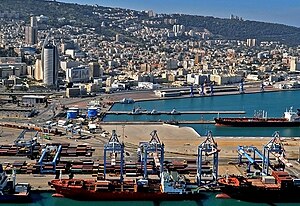Haifa Port
| Port of Haifa נמל חיפה |
|
|---|---|

The Port of Haifa
|
|
| Location | |
| Country |
|
| Location | Haifa |
| Coordinates | 32°49′12″N 35°00′16″E / 32.820118°N 35.00448°E |
| Details | |
| Opened | 1933 |
| Operated by | Israel Port Authority |
| Owned by | Government of Israel |
| Statistics | |
| Annual container volume | 1.36 million TEU (2013) |
| Passenger traffic | 253,524 (2013) |
|
Website haifaport.co.il |
|
The Port of Haifa (Hebrew: נמל חיפה) is the largest of Israel's three major international seaports, which include the Port of Ashdod, and the Port of Eilat. It has a natural deep water harbor which operates all year long, and serves both passenger and merchant ships. It is one of the largest ports in the eastern Mediterranean in terms of freight volume and handles about 26 million tons of cargo a year. The port employs over 1,000 people, with the number rising to 5,000 when cruise ships dock in Haifa. The Port of Haifa lies to the north of Haifa's downtown quarter on the Mediterranean, and stretches to some 3 kilometers along the city's central shore with activities ranging from military, industrial and commercial next to a nowadays-smaller passenger cruising facility.
Haifa Bay has been a refuge for mariners since prehistoric times. When the Crusaders conquered Haifa in the year 1100, it became an important town and the main port for Tiberias, the capital of the Galilee. The port fell into disrepair during the Mamluk reign, and acquired the reputation of a pirate lair in the 18th century.
Until the beginning of the 20th century, Acre served as the main port for the region. However, the port eventually became clogged with silt, and was unable to accommodate large ships. The first person to comprehend the tremendous possibilities of a port in Haifa was Theodor Herzl, the father of Political Zionism, who in 1902 wrote a prophetic description of the town in his book AltNeuland. Construction of the port began in 1922, and it was officially opened on October 31, 1933 by Lieut. Gen. Sir Arthur Wauchope, the British High Commissioner for Palestine. The port allowed Haifa to blossom, and in 1936, the city had over 100,000 inhabitants. The port was a gateway for thousands of immigrants to Israel after the Second World War. With Israel’s western borders the Mediterranean and the eastern borders sealed by its Arab neighbors, Haifa served as a crucial gateway to the rest of the world, and helped Israel develop into an economic power. Today the port brings both passenger and cargo traffic to a bustling metropolis, much as Theodor Herzl predicted over a century ago.
...
Wikipedia
